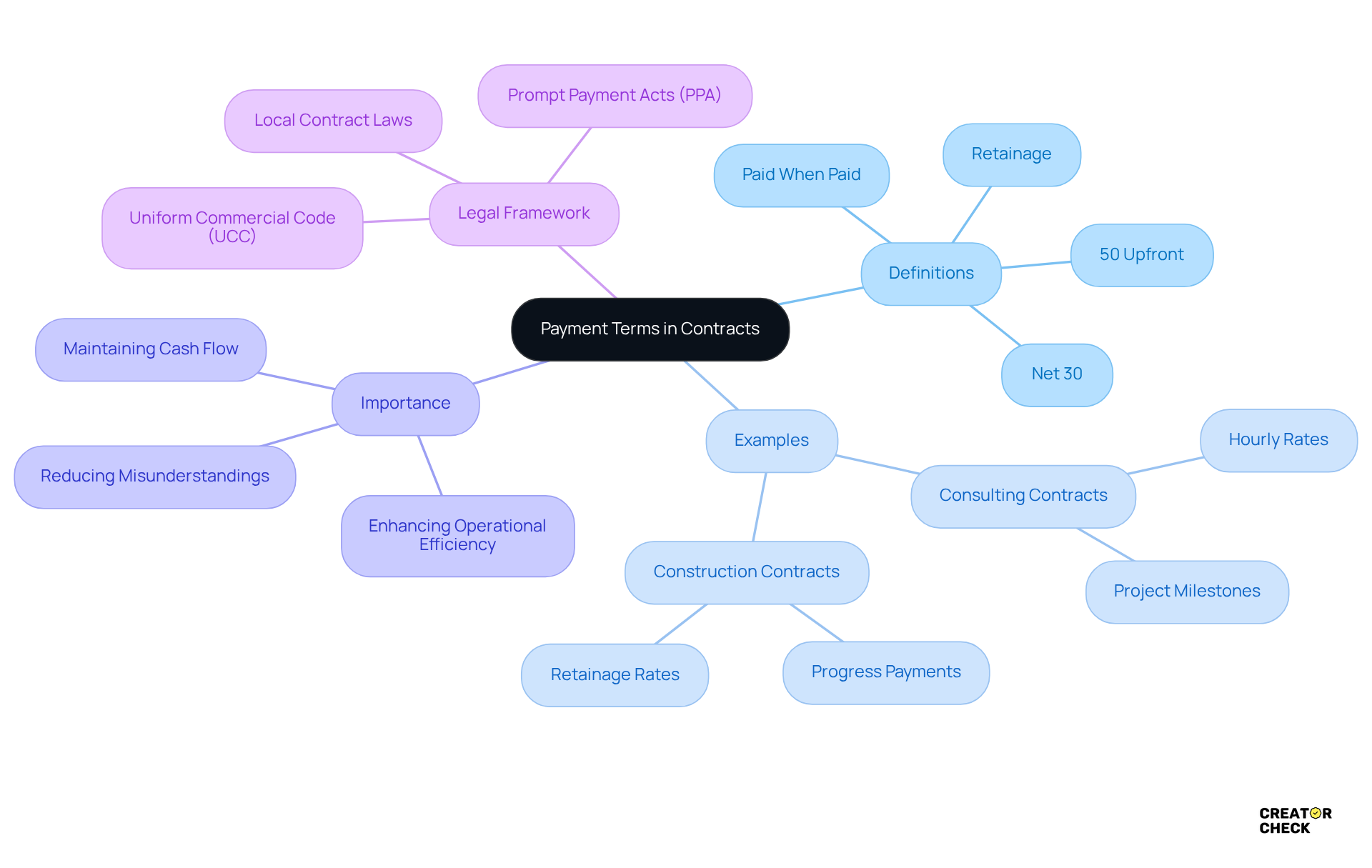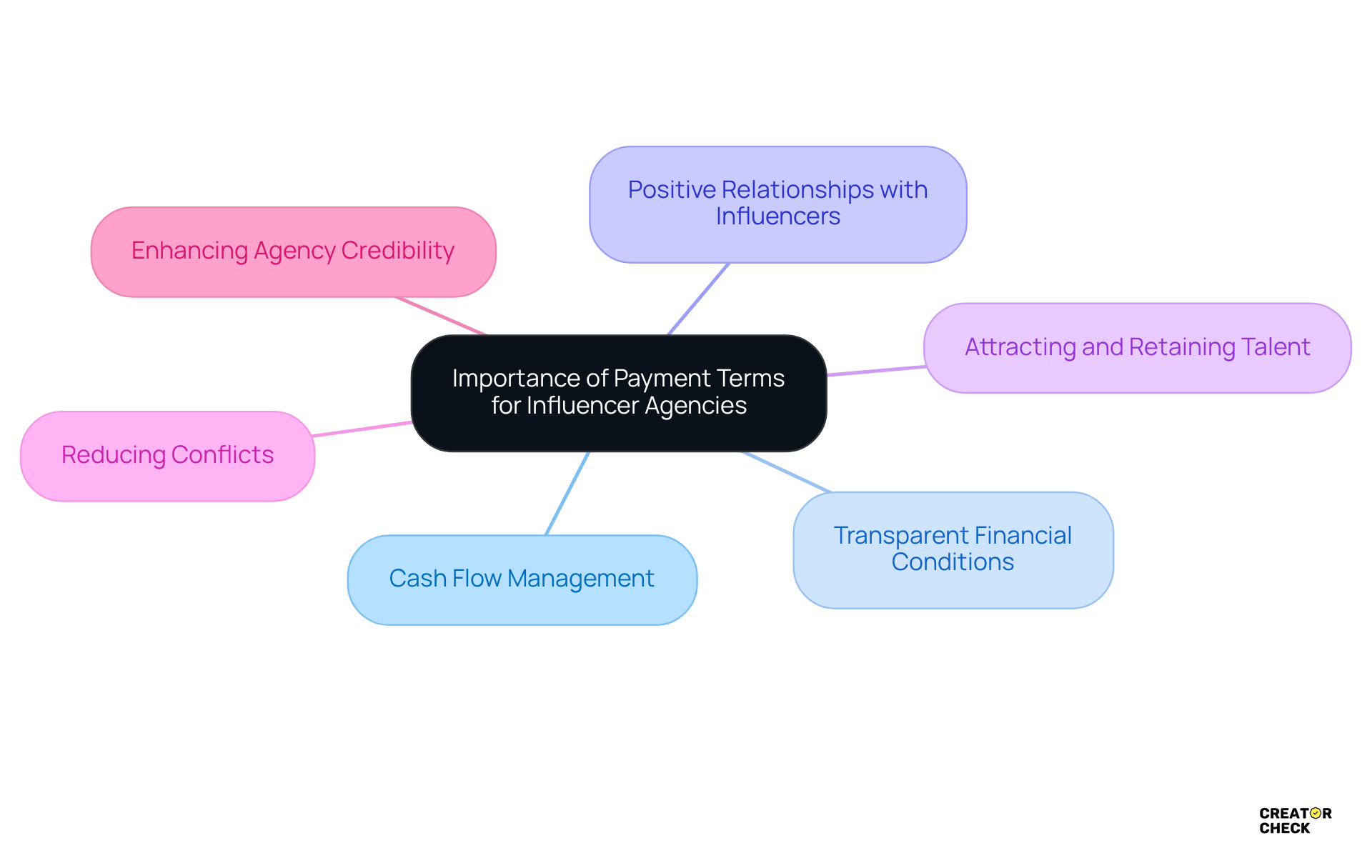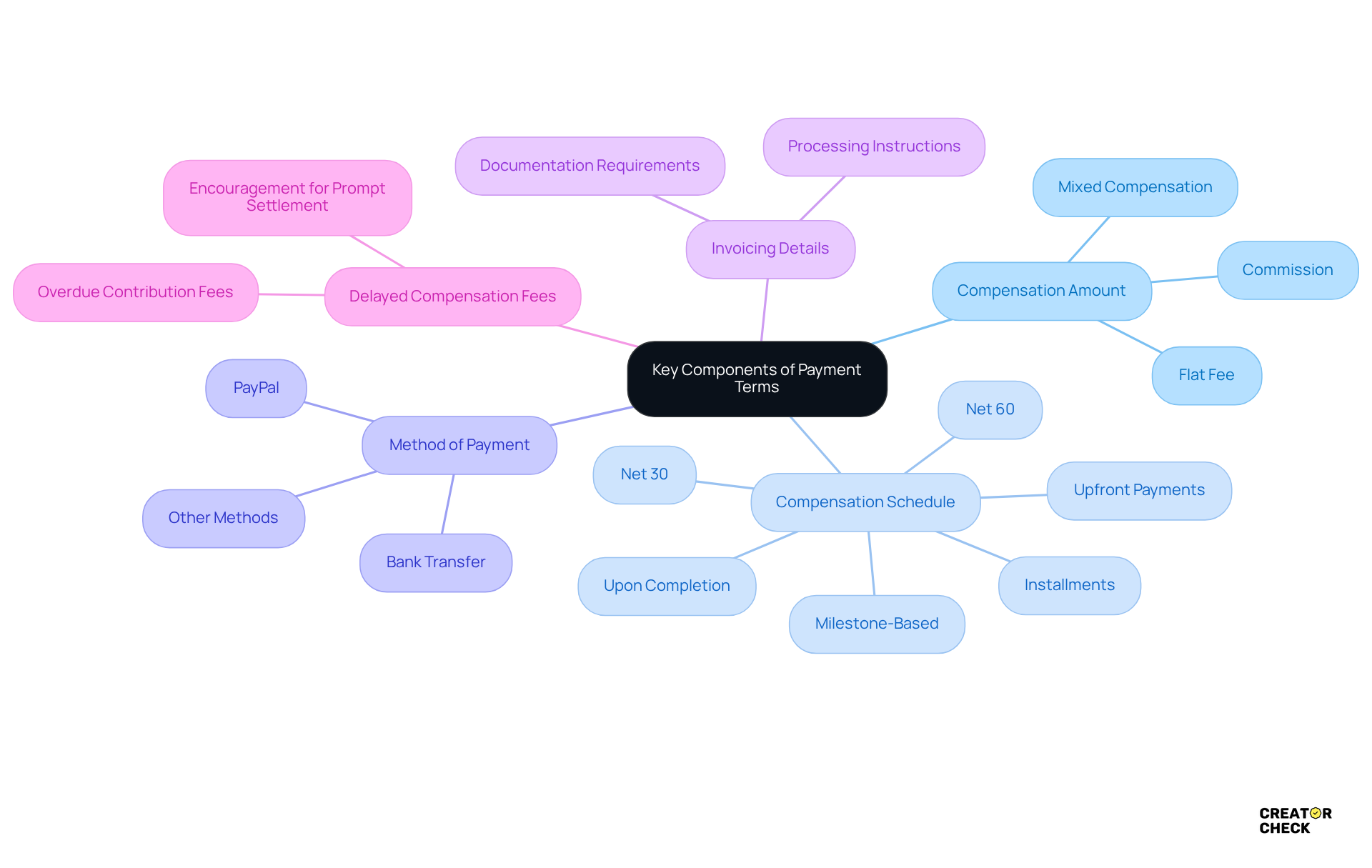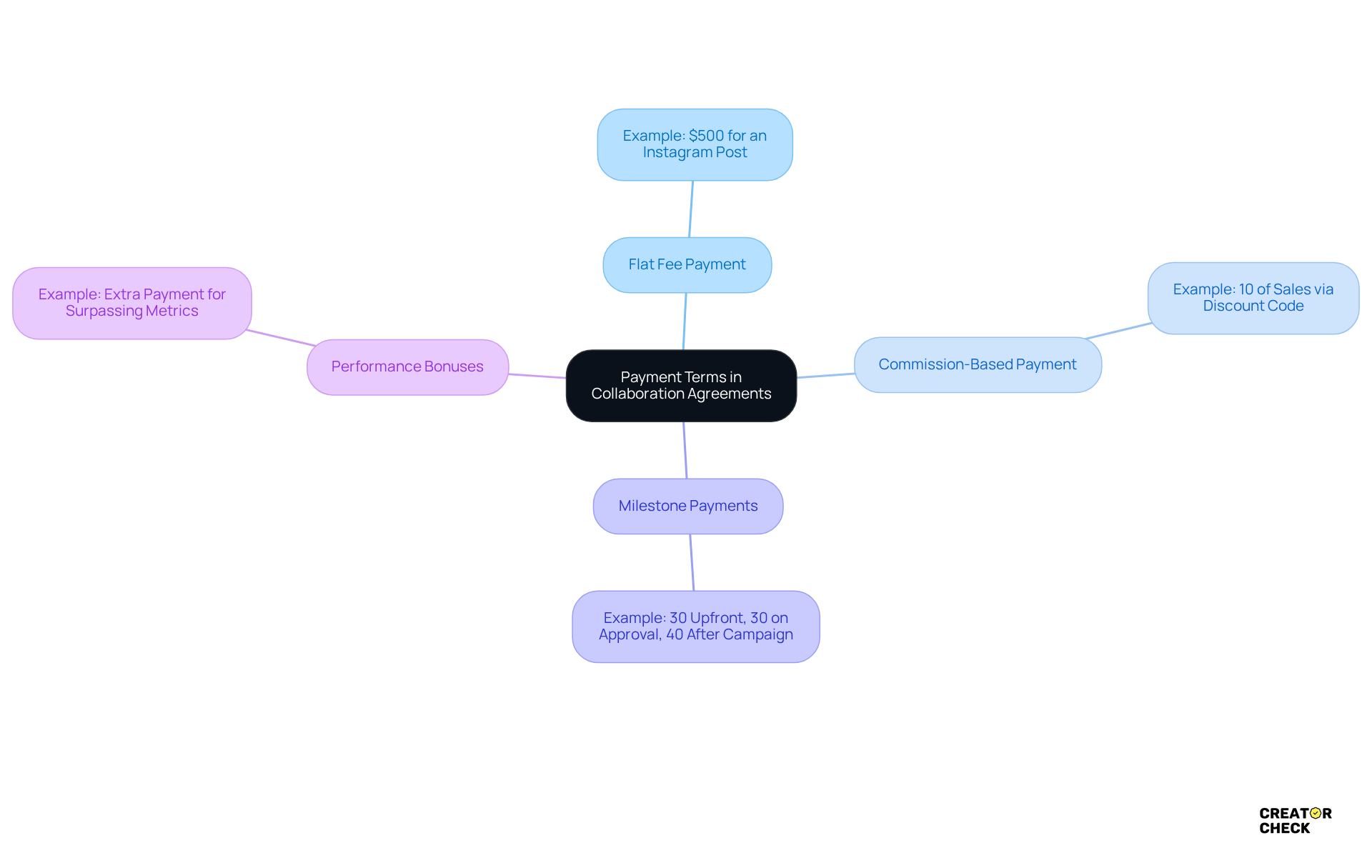Overview
This article dives into the payment terms that should be used in contracts for influencer agencies. It's all about making sure those financial conditions are crystal clear—after all, this is key for effective cash flow management and building strong relationships.
So, what does this mean for you? It highlights essential components like:
- Compensation amounts
- Schedules
- Methods of payment
When these terms are well-defined, they can really help prevent misunderstandings and foster trust between influencers and agencies. And isn't that what we all want?
Introduction
In the ever-changing world of influencer marketing, having clear financial agreements can really make or break a partnership. It’s super important for influencer agencies to grasp the ins and outs of payment terms in contracts if they want to build strong relationships with their collaborators.
But with so many options out there—like upfront payments, commissions, and milestone-based structures—what really defines the best approach?
Let’s dive into the key components and variations of payment terms and see how they can boost operational efficiency and trust in the fast-paced realm of social media marketing.
Define Payment Terms in Contracts
Conditions in agreements outline the specific stipulations that govern transactions between parties. These conditions cover things like the amount due, the timetable, and specify what payment terms to use in contracts. For instance, you might come across terms like 'Net 30', which means payment is expected within 30 days of the invoice date, or '50% upfront, 50% upon delivery', which illustrates what payment terms to use in contracts.
Setting clear financial conditions is super important for understanding what payment terms to use in contracts! It helps reduce misunderstandings and conflicts, ensuring that both influencers and agencies are on the same page about what payment terms to use in contracts. Did you know that the most common billing condition, which is important when considering what payment terms to use in contracts, is 'net 30 days'? In fact, nearly half of contractors give clients 30 days or longer to settle their invoices, illustrating what payment terms to use in contracts.
In the fast-paced marketing world, especially with social media personalities, timely transactions are crucial for maintaining cash flow and building solid relationships. Clearly outlined conditions about what payment terms to use in contracts can really enhance operational efficiency and trust between parties. As industry expert Armando Armendariz puts it, 'Setting clear expectations upfront, particularly regarding what payment terms to use in contracts, helps prevent misunderstandings and disputes later on.'
And let’s not forget about understanding the legal framework, like the Uniform Commercial Code (UCC), which regulates these conditions. Knowing this is key to ensuring that contracts are enforceable. So, what does this mean for you? It’s all about creating a smooth, transparent process that benefits everyone involved!

Understand the Importance of Payment Terms for Influencer Agencies
Influencer agencies must understand what payment terms to use in contracts, as these conditions are super important for cash flow management and the smooth operation of their activities. When financial conditions are transparent, agencies can easily figure out what payment terms to use in contracts to anticipate their revenue and keep costs in check. Plus, when influencers understand what payment terms to use in contracts and get paid promptly, it helps build positive relationships, boosting their morale and eagerness to collaborate on future campaigns.
Have you noticed how organizations that set clear compensation conditions tend to attract and retain top talent? Influencers really prefer working with brands that respect their financial needs. And let’s be real, having clearly outlined financial conditions, specifically what payment terms to use in contracts, can also help reduce conflicts—nobody wants drama that could hurt an agency's reputation in the competitive marketing world.
So, what does this mean for you? It’s all about creating a friendly and trustworthy environment where everyone feels valued. By prioritizing what payment terms to use in contracts, you not only enhance your agency’s credibility but also foster lasting partnerships with influencers.

Explore Key Components of Payment Terms
Let’s talk about the key components of payment terms that you should keep in mind:
-
Compensation Amount: It’s important to clearly specify the total remuneration for the influencer's services. Whether it’s a flat fee, commission, or a mix of both, make sure it’s laid out.
-
Compensation Schedule: When will the funds be disbursed? You might consider options like upfront payments, upon completion, or in installments. Typical schedules include Net 30, Net 60, or even milestone-based compensation.
-
Method of Payment: How will the transactions be processed? Will it be through bank transfer, PayPal, or perhaps another method? Get specific here.
-
Invoicing Details: Don’t forget to outline the invoicing requirements. What documentation do you need for processing those transactions?
-
Delayed Compensation Fees: It’s a good idea to specify any fees for overdue contributions. This can encourage prompt settlement.
By including these components, agencies can clarify what payment terms to use in contracts, ensuring that they craft clear and enforceable agreements that protect the interests of both parties. Remember, clarity in these terms not only builds trust but also sets the stage for a smooth partnership!

Review Examples and Variations of Payment Terms
In collaboration agreements, understanding what payment terms to use in contracts can really vary based on the type of partnership and what both parties prefer. Let’s take a look at some common variations:
-
Flat Fee Payment: This is where you agree on a set amount for a specific deliverable, like a social media post or video. For instance, a brand might pay a social media personality $500 for a single Instagram post.
-
Commission-Based Payment: Here, influencers earn a percentage of the sales that come from their promotional efforts. Imagine an influencer making 10% of sales through a unique discount code they share with their audience.
-
Milestone Payments: Payments can be structured at different stages of the campaign—maybe 30% upfront, another 30% when the content gets approved, and the final 40% after the campaign wraps up.
-
Performance Bonuses: This is where influencers can earn extra for surpassing certain performance metrics, like hitting a specific number of views or engagement rates.
These examples illustrate what payment terms to use in contracts, showcasing how flexible payment terms can be, allowing agencies to customize agreements to meet their needs and the expectations of influencers. So, what does this mean for you? It means there’s room to get creative and find what works best for your partnerships!

Conclusion
Establishing clear payment terms in contracts for influencer agencies is super important for building transparent and successful partnerships. When these terms are defined, it helps everyone involved understand their financial responsibilities, which ultimately cuts down on misunderstandings and boosts collaboration. You really can’t underestimate the importance of payment terms—they lay the groundwork for trust and smooth operations in the influencer marketing world.
In this article, we’ve explored key components of payment terms, like:
- Compensation amounts
- Payment schedules
- Methods of payment
- Invoicing details
- Any potential fees for late payments
Each of these elements is vital in crafting solid agreements that protect both influencers and agencies. Plus, we’ve looked at various payment structures—think flat fees, commission-based payments, and milestone payments—that show just how flexible you can be when creating contracts that fit specific partnerships.
So, why prioritize clear and fair payment terms? It’s not just about ticking boxes; it’s about building lasting relationships that benefit everyone involved. By adopting best practices in payment agreements, influencer agencies can boost their credibility and attract top talent, while influencers feel valued and motivated to jump into future collaborations. Embracing these principles can lead to a more harmonious and productive influencer marketing ecosystem, ensuring that everyone thrives in this dynamic industry.
Frequently Asked Questions
What are payment terms in contracts?
Payment terms in contracts are specific stipulations that govern transactions between parties, including the amount due, the timetable for payment, and the conditions under which payments should be made.
What does 'Net 30' mean in payment terms?
'Net 30' means that payment is expected within 30 days of the invoice date.
What is an example of a payment term structure?
An example of a payment term structure is '50% upfront, 50% upon delivery', which outlines when payments should be made during a transaction.
Why is it important to set clear payment terms in contracts?
Setting clear payment terms is important to reduce misunderstandings and conflicts, ensuring that both parties understand their financial obligations and expectations.
What is the most common billing condition in contracts?
The most common billing condition is 'net 30 days', as nearly half of contractors allow clients 30 days or longer to settle their invoices.
How do timely transactions impact relationships in the marketing world?
Timely transactions are crucial for maintaining cash flow and building solid relationships, particularly in the fast-paced marketing environment involving social media personalities.
What is the role of the Uniform Commercial Code (UCC) in payment terms?
The Uniform Commercial Code (UCC) regulates the conditions of contracts, and understanding it is key to ensuring that contracts are enforceable.
What is the overall goal of clearly outlining payment terms in contracts?
The overall goal is to create a smooth, transparent process that benefits everyone involved, enhancing operational efficiency and trust between parties.




